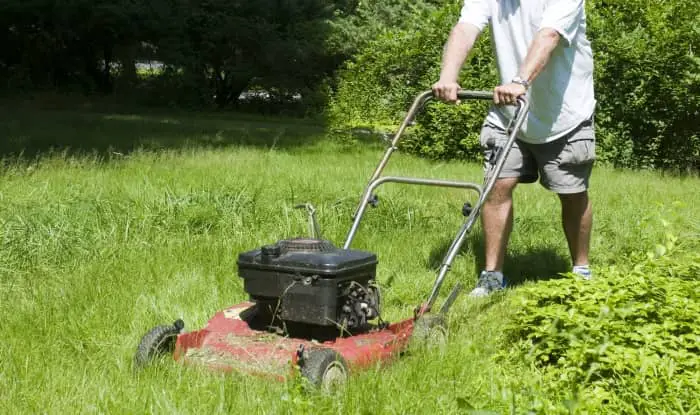You shouldn’t cut weeds before spraying. The most effective herbicides work by gaining access to weeds through their foliage. If you cut weeds before spraying, there will be less surface area available to absorb the herbicide, and you will be less likely to kill the plant. And despite being cut down, many weeds can regrow if you don’t kill or remove the roots.
Why You Should Wait To Cut Weeds After Spraying
Herbicides come in two types, contact and systemic.
Contact herbicides kill the parts of the plant you spray them on. But because they don’t kill the roots, perennial weeds will usually grow back. So you often have to apply contact herbicides each time the weed starts to regrow, eventually killing the plant by exhausting the root system. But this takes persistence and discipline.
To stop weeds from regrowing, many gardeners like to use a weed killer that contains a systemic herbicide instead.
Plants absorb systemic herbicide through their foliage. Once inside the weed, the chemical translocates through the vascular system, killing the plant from the inside. Because the roots die as well, the plant cannot regrow.
But systemic herbicides are slow to kill weeds. It takes time for herbicides to move from the point of entry in the foliage into the vascular system. So you should wait after spraying weeds before you cut them.
How Soon After Spraying Weeds Can I Mow?
Wait at least 48 hours after spraying before you mow or cut the weeds. This allows time for some of the herbicide to move into the plant vascular system. If you’re not in a rush, it’s better to wait until the weeds are dead before cutting them down. Systemic herbicide often takes 2-3 weeks to kill weeds.
Tips For Spraying Weeds
Weed killer works best when the weeds are actively growing.
It’s easier to kill small, young weeds than large, mature plants.
Using a surfactant helps the weed killer stick to weed leaves resulting in greater uptake and better results.
If you’re spraying your lawn, you should use a selective herbicide that kills broadleaf weeds such as 2,4-D. Some selective herbicides can also control specific species of grassy weeds without harming your turfgrass.
For spraying around building foundations, driveways, car parks, and patio stones, you can use a non-selective weed killer that kills all vegetation. The non-selective herbicide glyphosate is a popular choice for those areas.
If you’re spraying weeds on your lawn, do it when the temperature is less than 85° F to avoid harming the grass.
Tips For Cutting Weeds
If the lawn weeds are small, you can cut them down using your lawn mower or a string trimmer at the same time as cutting the grass down to your preferred size.
Tall weeds with thick, tough stalks will probably need a more powerful tool to cut them down, such as a brush cutter. You can also cut the weeds by hand using a scythe or a weeding knife.
If you’re cutting weeds on a hill then you can use a string trimmer. Sometimes a lawn mower is appropriate, but it depends on how steep the hill is.
Aim to cut weeds in your backyard before they have a chance to produce seeds. Otherwise, they will return in the next growing season.
Should I Cut Weeds After Spraying?
You don’t have to cut weeds after you spray them with herbicide. The weeds will die, and most will decompose, returning nutrients to the soil. But if the weeds were growing on your lawn, you might want to improve the appearance by mowing the weeds down. You can tidy up weeds growing through cracks in your driveway or between paving stones with an appropriate tool.



